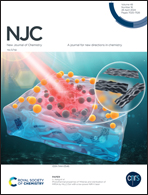Citrus sap-stabilized regulated cobalt ferricyanide efficiently enhanced electrocatalytic activity and durability for oxygen evolution†
Abstract
Water electrolysis is considered the most promising technology for hydrogen production. In the present study, RCoFe (regulated cobalt ferricyanide) is synthesized via the co-precipitation method, which is characterized by physical and electrochemical properties. XRD confirmed the crystalline phase of RCoFe and the diffraction peaks are consistent with JCPDS#82-2284. FE-SEM examines the nanoplatelet morphology, which could help with the mass transfer of electrons during the electrochemical process. Here, RCoFe promotes the extensive activity for the OER (oxygen evolution reaction) with 270 mV/GC; 252 mV/NF at 10 mA cm−2. The lower Tafel value for RCoFe (78 mV dec−1/GC; 107 mV dec−1/NF) was derived from LSV when compared to IrO2 (98 mV dec−1/GC; 123 mV dec−1/NF) and stable for a long time with minimal loss of potential (130 h/GC-1.5%; 250 h/NF-1.8%) owing to citrus sap, which stabilized the electrocatalyst. After electrochemical treatment, the post-SEM morphology reveals that the nanoplatelets are completely bound together to enhance the OER process.



 Please wait while we load your content...
Please wait while we load your content...